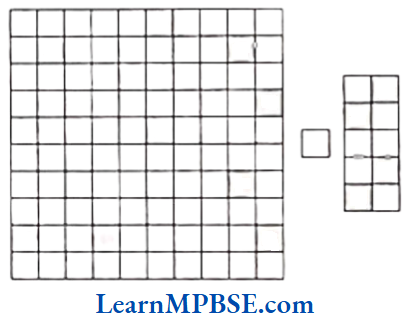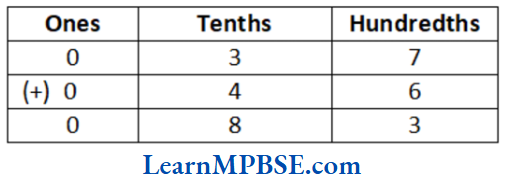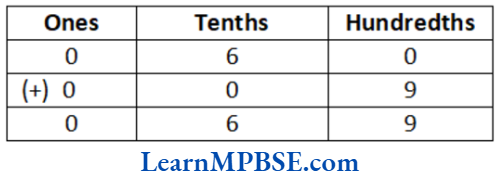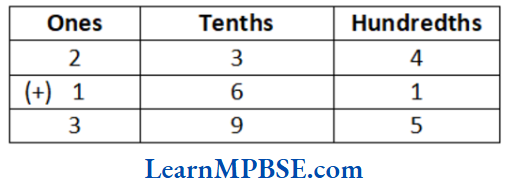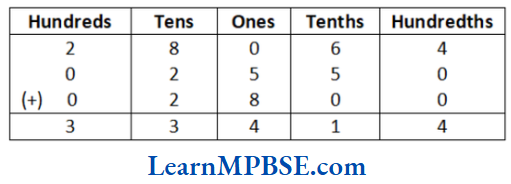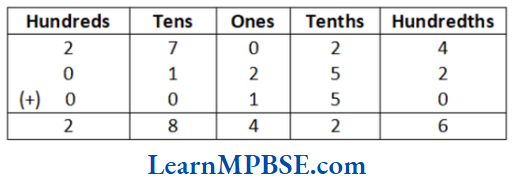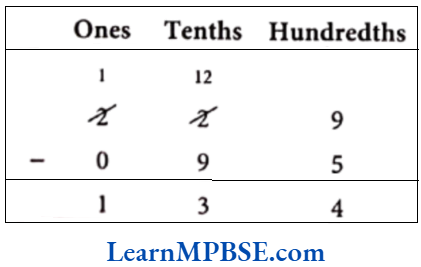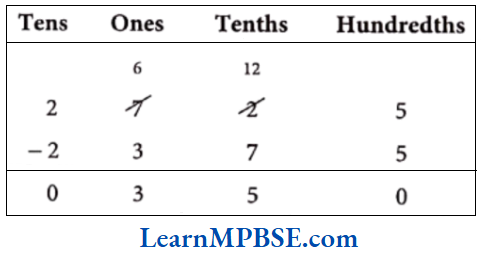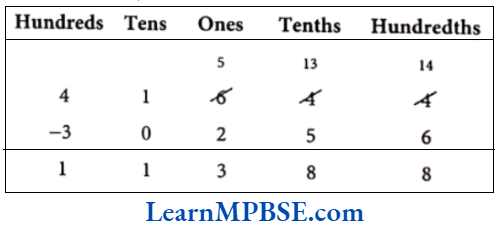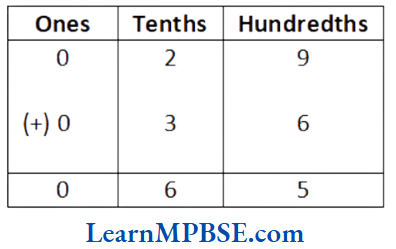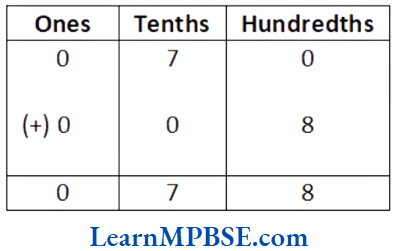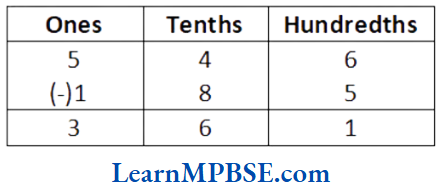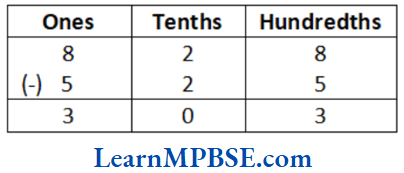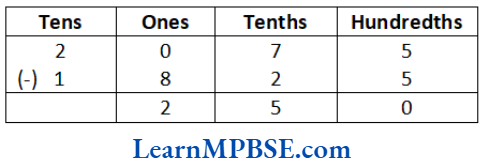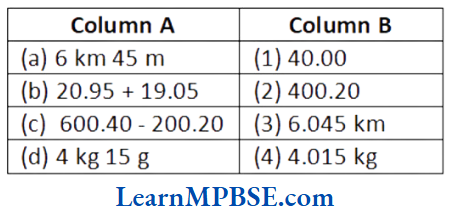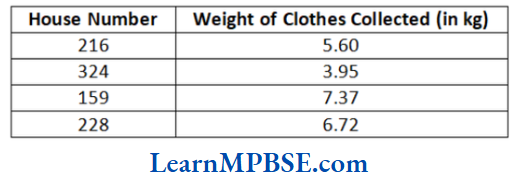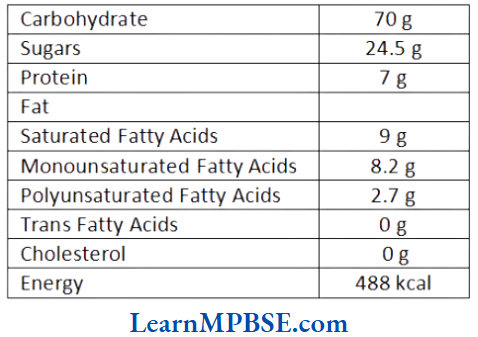Free downloadable MP Board solutions for Class 6 Maths Chapter 1 Knowing Our Numbers
Class 6 Maths chapter-wise solutions PDF Comparing Numbers
In comparison of two numbers, a number having more number of digits will be greater and a number having less number of digits will be smaller.
e.g. Let 92 and 395 be given numbers. It is clear that number 395 has greater number of digits. Hence, 395 is the greatest number.
If the number of digits in two or more numbers are same, then that number will be larger which has a greater leftmost digit. If this digit also happens to be the same, we look at the next digit and so on.
e.g. Let 395 and 424 be given numbers. Here, both given numbers have same number of digits but 424 has a greater leftmost digit (4 as compared to 3). Hence, 424 is greater number.
Mp Board Class 6 Maths Solutions
Example 1. By instantly looking at the numbers, find which one is the greatest and which one is the smallest in each of the following.
(1) 29, 210, 198, 1234
(2) 19, 311, 218, 4310
(3) 741965, 769, 7064, 8094
(4) 73156, 1369, 18088, 9173231
Solution. (1) Number of digits in 29 = 2
Number of digits in 210 = 3
Number of digits in 198 = 3
Number of digits in 1234 = 4
∴ Greatest number=1234 [maximum number of digits]
Read and Learn More MP Board Class 6 Maths Solutions
and smallest number=29 [minimum number of digits]
(2) Number of digits in 19 = 2
Number of digits in 311 = 3
Number of digits in 218 = 3
Number of digits in 4310 = 4
∴ Greatest number = 4310 [maximum number of digits)
and smallest number=19 [minimum number of digits]
(3) Number of digits in 741965 = 6
Number of digits in 769 = 3
Number of digits in 7064 = 4
Number of digits in 8094 = 4
∴ Greatest number=741965 [maximum number of digits]
and smallest number=769 [minimum number of digits]
(4) Number of digits in 73156 = 5
Number of digits in 1369 = 4
Number of digits in 18088 = 5
Number of digits in 9173231=7
∴ Greatest number=9173231 [maximum number of digits]
and smallest number = 1369 [minimum number of digits]
Mp Board Class 6 Maths Solutions
Example 2. Compare the following number.
(1) 67454 and 78465
(2) 97632 and 96543
(3) 956 and 987
(4) 86545 and 86575
Solution. (1) Both 67454 and 78465 have same number of digits. Now, on comparing first digit from left, we get
6 < 7
∴ 67454 < 78465
(2) Both 956 and 987 have same number of digits and first leftmost digit is also same.
Now, on comparing second digit from left, we get
5 < 8
∴ 956 < 987
(3) Both 97632 and 96543 have same number of digits and first leftmost digit is also same.
Now, on comparing second digit from left, we get
7 > 6
∴ 97632 > 96543
(4) Both 86545 and 86575 have same number of digits and its three digits from left are also same.
Now, on comparing fourth digit from left, we get
4 < 7
∴ 86545 < 86575
MP Board Solutions For Class 6 Maths Chapter 1 Ordering Of Numbers
Ordering of numbers is the arrangements of numbers from smallest to greatest or from greatest to smallest.
Ascending order is the method of arranging the numbers from smallest to greatest.
While descending order is the method of arranging the numbers from greatest to smallest number.
Example 3. Arrange the following numbers in ascending order.
(1) 847, 9754, 8320, 571
(2) 911, 713, 5168, 7431
(3) 3691, 3699, 4312, 4319
(4) 2231, 2291, 2278, 2201
Solution. (1) To convert numbers into ascending order, we arrange numbers from smallest to greatest.
Now, ascending order is
571 < 847 < 8320 < 9754.
(2) To convert numbers into ascending order, we arrange numbers from smallest to greatest.
Now, ascending order is
713 < 911 < 5168 < 7431.
(3) To convert numbers into ascending order, we arrange numbers from smallest to greatest.
Now, arranging them in ascending order
3691 < 3699 < 4312 < 4319.
(4) To convert numbers into ascending order, we arrange numbers from smallest to greatest.
Now, ascending order is
2201 < 2231 < 2278 < 2291.
Class 6 Maths Chapter 1 Solutions
Example 4. Arrange the following numbers in descending order.
(1) 719, 3250, 571, 8256
(2) 819, 5240, 890, 6249
(3) 31093, 31309, 39031, 9391, 31029
(4) 21025, 21206, 29031, 5625, 21029
Solution. (1) To convert number into descending order, we arrange the numbers from greatest to smallest.
Now, descending order of the given numbers is
8256 > 3250 > 719 > 571.
(2) To convert number into descending order, we arrange the numbers from greatest to smallest.
Now, descending order of the given numbers is
6249 > 5240 > 890 > 819.
(3) To convert number into descending order, we arrange the numbers from greatest to smallest.
Now, descending order of the given numbers is
39031 > 31309 > 31093 > 31029 > 9391.
(4) To convert number into descending order, we arrange the numbers from greatest to smallest.
Now, descending order of the given numbers is
29031 > 21206 > 21029 > 21025 > 5625.
MP Board Solutions For Class 6 Maths Chapter 1 Formation Of Smallest And Greatest Numbers
Suppose some digits are given to form greatest number and smallest number.
For greatest number We arrange the given digits in descending order of their values.
For smallest number We arrange the given digits in ascending order of their values.
e.g. The smallest 4-digit number using 5, 3, 4, 2 is 2345 and the greatest 4-digit number using the same digits is 5432.
Example 5. Use the following digits without repetition and make the greatest and smallest 4-digit numbers.
(1) 2, 8, 7, 6
(2) 9, 5, 4, 1
(3) 3, 8, 5, 0
(4) 2, 3, 6, 7
Solution. (1) Descending order of the given digits is 8, 7, 6, 2.
∴ Greatest 4-digit number = 8762
and ascending order of the given digits is 2, 6, 7, 8
∴ Smallest 4-digit number = 2678
(2) Descending order of the given digits is 9, 5, 4, 1.
∴ Greatest 4-digit number = 9541
and ascending order of the given digits is 1,4,5,9
∴ Smallest 4-digit number = 1459
(3) Descending order of the given digits is 8, 5, 3,0
∴ Greatest 4-digit number = 8530
and ascending order of the given digits is 0, 3, 5, 8
∴ The smallest number is 0 which can’t be placed at left most place.
∴ Smallest 4-digit number = 3058
Class 6 Maths Chapter 1 Solutions
Note it While forming a smallest number from given number of digits, zero cannot be placed at leftmost digit. As zero will be meaningless in counting and 4-digit number will become 3-digit number and so on.
(4) Descending order of the given digits is 7, 6, 3, 2.
∴ Greatest 4-digit number = 7632
and ascending order of the given digits is 2, 3, 6, 7
∴ Smallest 4-digit number = 2367
Class 6 Maths Exercises With Answers
Example 6. Make the greatest and the smallest 4-digit numbers using any one digit twice.
(1) 3,6,7
(2) 8, 1, 5
(3) 0, 7, 9
(4) 5, 4, 0
Solution. (1) Descending order of the given digits is 7, 7, 6, 3.
[∵ greatest digit is taken twice]
∴ Greatest 4-digit number = 7763
and ascending order of the given digits is 3, 3, 6, 7. [∵ smallest digit is taken twice]
∴ Smallest 4-digit number = 3367
(2) Descending order of the given digits is 8, 8, 5, 1
[∵ greatest digit is taken twice]
∴ Greatest 4-digit number = 8851
and ascending order of the given digits is 1, 1, 5, 8. [∵ smallest digit is taken twice]
∴ Smallest 4-digit number = 1158
(3) Descending order of the given digits is 9,9,7,0.
[∵ greatest digit is taken twice]
∴ Greatest 4-digit number = 9970
and ascending order of the given digits is 0, 0, 7, 9.
[∵ smallest digit is taken twice]
But 0079 is a 2-digit number. So, keeping 7 (instead of 0) at the left most place and taking the smallest digit twice i.e. 7009.
∴ Smallest 4-digit number = 7009
(4) Descending order of the given digits is 5, 5, 4, 0.
∴ Greatest 4-digit number = 5540
and ascending order of the given digits is 0, 0, 4, 5.
But 0045 is a 2-digit number. So, keeping 4 (instead of 0) at the left most place and taking the smallest digit twice i.e. 4005.
∴ Smallest 4-digit number = 4005
Class 6 Maths Exercises With Answers
Example 7. Make the greatest and the smallest 4-digit numbers using any four different digits if
(1) Digit 5 is always at ones place.
(2) Digit 3 is always at tens place.
(3) Digit 1 is always at thousands place.
Solution. Writing digits written in descending order as 9, 8, 7, 6, 5, 4, 3, 2, 1, 0
(1) According to the question, digit 5 is always at ones place.
∴ Greatest number = 9875
and Smallest number = 1025
(2) According to the question, digit 3 is always at tens place.
∴ Greatest number = 9837
and Smallest number = 1032
(3) According to the question, digit 1 is always at thousands place.
∴ Greatest number = 1987
and Smallest number = 1023
Shifting Digits
Shifting digits means changing the position of the digits in a number.
e.g. Consider two numbers 419 and 941. We observe that both the numbers have same digits but their places are different.
So, if the digits of a number are shifted, then the number also gets change.
MP Board solutions for Class 6 Maths Chapter 1 Greatest Number and Smallest Number
On adding 1 to the greatest n-digit number, we would get the smallest (n+1)-digit number.
e.g. Greatest 2-digit number + 1 = Smallest 3-digit number
i.e. 99 + 1 = 100
(1) Greatest 3-digit number = 999
∴ Smallest 4-digit number = 1000
(2) Greatest 4-digit number = 9999
∴ Smallest 5-digit number = 10000
(3) Greatest 5-digit number = 99999
∴ Smallest 6-digit number = 100000
(4) Greatest 6-digit number = 999999
∴ Smallest 7-digit number = 1000000
(5) Greatest 7-digit number = 9999999
∴ Smallest 8-digit number = 10000000
(6) Greatest 8-digit number = 99999999
∴ Smallest 9-digit number = 100000000
Note it
(1) One hundred = 10 tens
(2) One thousand = 10 hundreds = 100 tens
(3) One lakh 100 thousands = 1000 hundreds
(4) One crore = 100 lakhs = 10000 thousands
(5) One million = 1000 thousands = 10 lakhs
(6) One billion = 1000 millions
Example 8. Starting from the greatest 7-digit number, write the previous 4 numbers in descending order.
Solution. The greatest 7-digit number = 9999999
1st previous number = 9999999 – 1 = 9999998
2nd previous number = 9999999 – 2 = 9999997
3rd previous number = 9999999 – 3 – 9999996
4th previous number = 9999999 – 4 = 9999995
Now, descending order of these number is as follows 9999998 > 9999997 > 9999996 > 9999995
MP Board Solutions For Class 6 Maths Chapter 1 Use Of Commas
Commas help us in reading and writing large numbers. To make reading of large numbers easy, we group various places into periods. This can be done in two different ways:
Indian System of Numeration
In the Indian system of numeration, we use commas after 3 digits starting from the right and there after every 2 digits. The commas after 3, 5 and 7 digits separate thousand, lakh and crore respectively.

Example 9. Read the numbers and write them using placement boxes.
(1) 475320 (2) 8675964312
Solution. (1) Given number is 475320.
According to the Indian system of numeration,

We read it as, four lakh seventy five thousand three hundred twenty.
Using the commas it is written as 4,75,320.
(2) Given number is 8675964312.
According to the Indian system of numeration,

We read it as eight arab sixty seven crore fifty nine lakh sixty four thousand three hundred twelve. Using commas it written as 8, 67, 59, 64, 312.
Note it While writing number names, we do not use commas.
Mpbse Class 6 Maths Chapter 1
International System of Numeration
In the international system of numeration, commas are placed after every 3 digits starting from the right. The commas after 3 and 6 digits separate thousand and million respectively.

Example 10. Read the numbers and write them using placement boxes.
(1) 9578432
(2) 3572893921
Solution. (1) According to the International system of numeration,

We read it as nine million five hundred seventy eight thousand four hundred thirty two and write as 9, 578, 432.
(2) According to the International system of numeration,

We read it as three billion five hundred seventy two million eight hundred ninety three thousands nine hundred twenty one and write as 3,572, 893, 921.
Mpbse Class 6 Maths Chapter 1
Example 13. Place commas correctly and write numerals.
(1) Fifty three lakh seventy five thousand three hundred seven.
(2) Eight crore five lakh forty one.
(3) Six crore fifty two lakh twenty one thousand three hundred two.
Solution.

MP Board solutions for Class 6 Maths Chapter 1 Place Value and Face Value
Place Value
The place value is the position of each digit in a number which is determined as ones, tens, hundreds, thousands and so on.
e.g. The place value of 1 in 1854 is 1000.
Face Value
The face value is the actual value of the digit in a number. e.g. Face value of 1 in 1854 is 1 only.
The expanded form of the number 1854 is 1 x 1000 + 8 x 100 + 5 x 10 + 4 x 1.
Example 14. Find the place and face values of
(1) 7 in number 97621 (2) 2 in number 25687
Solution. (1) Place value of 7 in 97621 is 7000 and face value of 7 is 7.
(2) Place value of 2 in 25687 is 20000 and face value of 2 is 2.
Example 15. Write the expanded form of the following numbers.
(1) 20000 (2) 38400 (3) 65740 (4) 89324
Solution. (1) 20000 = 2 × 10000
(2) 38400 = 3 x 10000 + 8 x 1000 + 4 x 100
(3) 65740 = 6 x 10000 + 5 x 1000 + 7 x 100 + 4 × 10
(4) 89324 = 8 × 10000 + 9 x 1000 + 3 × 100 + 2 × 10 + 4 × 1
Mpbse Class 6 Maths Chapter 1
Example 16. Write the place value of each digit in the numeral
(1) 369868
(2) 97263480
Solution. (1) Place value of 8 = 8 x 1 = 8
Place value of 6 = 6 x 10 = 60
Place value of 8 = 8 x 100 = 800
Place value of 9 = 9 x 1000 = 9000
Place value of 6 = 6 x 10000 = 60000
Place value of 3 = 3 x 100000 = 300000
(2) Place value of 0 = 0 x 1 = 0
Place value of 8 = 8 x 10 = 80
Place value of 4 = 4 x 100 = 400
Place value of 3 = 3 x 1000 = 3000
Place value of 6 = 6 x 10000 = 60000
Place value of 2 = 2 x 100000 = 200000
Place value of 7 = 7 x 1000000 = 7000000
Place value of 9 = 9 x 10000000 = 90000000
Example 17. Find the sum of place and face values for the following.
(1) 2 in 12456 (2) 5 in 54321
Solution. (1) Place value of 2 = 2000
Face value of 2 = 2
∴ Sum = 2000 + 2 = 2002
(2) Place value of 5 = 50000
Face value of 5 = 5
∴ Sum = 50000 + 5 = 50005
Example 18. Find the differences of place values for the following conditions.
(1) two 7s in 7652713 (2) two 4s in 43810422
Solution. (1) The place value of 7 in ten lakhs place = 70000000
The place value of 7 in hundreds place = 700
Hence, the required difference = 7000000-700 =6999300
(2) The place value of 4 at the crores place = 40000000
The place value of 4 at the hundreds place = 400
Hence, the required difference = 40000000 – 400 = 39999600
Number Comparison Examples Class 6
Example 19. Answer the following questions.
(1) How many 5 – digit numbers are there in all?
(2) How many 7 – digit numbers are there in all?
(3) Write the smallest 8 – digit number having five different digits.
Solution. (1) The largest 5 – digit number = 99999
The smallest 5-digit number = 10000
Number of all 5-digit numbers = (99999 – 10000) +1
= (89999 + 1) = 90000
Hence, there are in all ninety thousand of 5-digit numbers.
(2) The largest 7-digit number = 9999999
The smallest 7 – digit number = 1000000
Number of all 7 – digit numbers
= (9999999 -1 000000) + 1
= (8999999 + 1) = 9000000 = Ninety lakh
Hence, there are in all ninety lakh of 7-digit numbers.
(3) Five smallest digits are 0, 1, 2, 3, 4.
Hence, the required number is 10000234.
MP Board solutions for Class 6 Maths Chapter 1 Large Numbers in Practice
Large numbers are needed is many places in daily life.
e.g. Number of people in a city, money paid or recieved in large transactions etc.
Generally, larger numbers are used to measure length, mass and capacity etc.
The standard unit for measuring length, mass and capacity are metre, grams and litres respectively. The relation between the various units is given by
The units kilo is the greatest and milli is the smallest.
(1) 1 kilometre = 1000 metres
1 metre = 10 decimetre = 100 centimetres
(2) 1 kilogram = 1000 grams
1 gram = 10 decigrams = 100 centigrams = 1000 milligrams
(3) 1 litre 10 decilitres = 100 centilitres = 1000 millilitres
Example 1. A tourist car travelled from different places with a speed 40 km/h. The journey is shown below. 1020 km
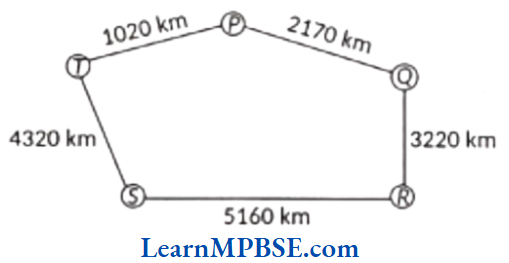
(1) Find the total distance covered from P to R.
(2) Find the total distance covered from R to T.
(3) Find the total distance covered by the car if it starts from P and returns back to P.
(4) Find the difference of distances from Q to R and R to S.
(5) Find out the time taken by the car to reach.
(a) P to Q
(b) R to S
(c) Total journey
Solution. From the given figure,
(1) Total distance covered by car from P to R
= PQ + QR = 2170 + 3220 = 5390 km
(2) Total distance covered by car from R to T
= RS + ST = 5160 + 4320 = 9480 km
(3) Total distance covered by car
= Distance from P to R + Distance from R to T + Distance from T to P
= 5390 + 9480 + 1020 = 15890 km
(4) Distance from Q to R = 3220 km
Distance from R to S = 5160 km
∴ Difference of distances from Q to R and R to S = 5160 – 3220 = 1940 km
(5) We know that Time \(=\frac{\text { Distance }}{\text { Speed }}\)
(a) Time taken by the car to reach P to Q Distance from P to Q
\(=\frac{\text { Distance from } P \text { to } Q}{\text { Speed }}\)= \(\frac{2170}{40}=\frac{217}{4}=54 \frac{1}{4} \mathrm{~h}\)
(b) Time taken by the car to reach R to S
\(=\frac{\text { Distance from } R \text { to } S}{\text { Speed }}\)= \(\frac{5160}{40}=129 \mathrm{~h}\)
(c) Total journey \(=\frac{\text { Total distance covered }}{\text { Speed }}\)
= \(\frac{15890}{40}=\frac{1589}{4}=397 \frac{1}{4} \mathrm{~h}\)
Number Comparison Examples Class 6
Example 2. The distance between the office and flat of a employee’s house is 2 km 575 m. Everyday she walks both ways. Find the total distance covered by her in 10 days.
Solution. Distance between the office and the flat = 2 km 575 m
= 2 × 1000 + 575 = 2000 + 575
= 2575 m [∴ 1 km = 1000 m]
∴ Distance covered by the employee in one day
= 2 × 2575 = 5150 m
[∴ she walks both ways in one day]
∴ Distance covered in 10 days = 10 x 5150 = 51500 m
= (51 × 1000 + 500) m
= 51 km 500 m
Example 3. If a box contains 400000 medicine tablets each and weight of one tablet is 20 mg. What is the total weight of all tablets in the box in grams and in kilograms both?
Solution. Weight of one tablet = 20 mg
Total weight of 400000 tablets in the box = 400000 x 20 mg =8000000 mg
Now, weight in grams = \(\frac{8000000}{1000} \mathrm{~g}=8000 \mathrm{~g}\)
[∴ \(1 \mathrm{mg}=\frac{1}{1000} \mathrm{~g}\)]
Now, weight in kilograms = \(\frac{8000}{1000} \mathrm{~kg}=8 \mathrm{~kg}\)
[∴ \(1 \mathrm{~g}=\frac{1}{1000} \mathrm{~kg}\)]
Example 4.
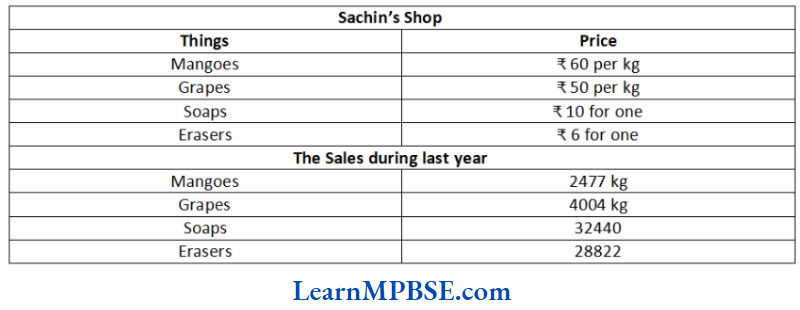
(1) Can you find the total weight of mangoes and grapes Sachin sold last year?
(2) Can you find the total money Sachin got by selling mangoes?
(3) Can you find the total money Sachin got by selling mangoes and grapes together?
(4) Make a table showing how much money Sachin received from selling each item? Arrange the entries of amount of money received in descending order. Find the item which brought him the highest amount.
Solution. (1) Total weight of mangoes and grapes Sachin sold
= 2477 + 4004 = 6481kg
(2) Total money Sachin got by selling mangoes
= Total weight of mangoes in kg x Cost per kg = 2477 x 60 = 148620
(3) Total money Sachin got by selling grapes = 4004 × 50 = 200200
(4) Following table shows the money received from selling items.

The entries of amount of money received in descending order are as follows
₹ 324400 > 200200 > 172932 > 148620
The item, which brought him the highest amount is Soaps i.e. ₹ 324400.
MPBSE Class 6 Maths Chapter 1
Example 5. A box contains 50 packets of biscuits. Each weights 120 g. How many such boxes be loaded into a van which cannot carry beyond 900 kg?
Solution. Given, total number of packets = 50
Weight of each packets = 120 g
Weight of a box = 50 x 120 g = 6000 g = 6 kg
∴ Required number of boxes = \(\frac{900}{6}=150\)
Hence, only 150 boxes can be loaded in the van.
Example 6. A milk dairy produced 75678 L of milk in a day. It supplied 67689 L of milk to milk depot. Find the milk left in the dairy.
Solution. Production of milk in one day = 75678 L
Supply to milk depot in one day = 67689 L
So, the milk left in the dairy=75678-67689=7989 L
Example 7. A vessel has 2 L and 500 mL of juice. In how many glasses, each of 20 mL capacity, can it be filled?
Solution. Capacity of vessel = 2 L 500 mL = 2 x 1000 + 500 = 2000 + 500 = 2500 mL
[∴ 1 L=1000 mL]
and capacity of one glass = 20 mL
∴ Number of glasses of juice filled out of vessel
\(=\frac{\text { Capacity of a vessel }}{\text { Capacity of a glass }}=\frac{2500}{20}=125\)Hence, juice can be filled in 125 glasses.
MPBSE Class 6 Maths Chapter 1
Example 8. Population of Bhavnagar was 356213 in the year 1990. In the year 2000, it was found to be increased by 62578. What was the population of the city in 2000?
Solution. Population of the city in year 2000
= Population of the city in year 1990 + Increase in population
= 356213 + 62578 = 418791
Example 9. In a country, the number of electronic cars sold in the year 2020-2021 was 200880. In the year 2021-2022, the number of electronic cars sold was 400100. In which year more cars were sold and how many more?
Solution. Clearly, 400100 is more than 200880. So, more cars were sold in the year 2021-2022 than in 2020-2021.
Now, 400100 – 200880 = 199220
Check the answer by adding
200880 + 199220 = 400100 (the answer is right)
Example 10. Every Friday a small brochure of general knowledge is published with a newspaper. One copy has 10 pages. Every week 12444 copies are printed. How many total pages are printed every Friday?
Solution. Every copy has 10 pages.
∴ 12444 copies will have 12444 x 10 pages.
Now, 12444 × 10 = 124440
Thus, every Friday 124440 pages are printed.
Example 11. If a number 6253 multiplied by 55 instead of multiplying by 46. By how much was the answer greater than the correct answer?
Solution. After multiplying 6253 by 55, we get
= 6253 × 55
= 343915
After multiplying 6253 by 46, we get
= 6253 × 46 = 287638
Difference 343915 – 287638 = 56277
Wrong answer is 56277 greater than the actual answer.
Example 12. The cost of a autograph signed bat is 30222. What is the cost of 25 such bats?
Solution. Cost of 1 autograph signed bat=30222
∴ Cost of 25 autograph signed bat = 30222 x 25 = ₹ 755550
Example 13. Find the difference between the greatest and the least numbers that can be written using the digits 8, 2, 5, 4, 1 each only one.
Solution. Using the digits 8, 2, 5, 4, 1, we get
Greatest number = 85421 and least number = 12458
∴ Difference = 85421 – 12458
= 72963
MP Board solutions for Class 6 Maths Chapter 1
Question 1. Can you instantly find the greatest and the smallest numbers in each row?
(1) 382, 4972, 18, 59785, 750
(2) 1473, 89423, 100, 5000, 310
(3) 1834, 75284, 111, 2333, 450
(4) 2853, 7691, 9999, 12002, 124 Was that easy? Why was it easy?
Solution.
(1) Number of digits in 382 = 3
Number of digits in 4972 = 4
Number of digits in 18 = 2
Number of digits in 59785 = 5
Number of digits in 750 = 3
∴ Greatest number = 59785 [maximum number of digits]
and smallest number = 18 [minimum number of digits]
(2) Number of digits in 1473 = 4
Number of digits in 89423 = 5
Number of digits in 100 = 3
Number of digits in 5000 = 4
Number of digits in 310 = 3
Answer. Greatest number = 89423
Smallest number=100
(3) Number of digits in 1834 = 4
Number of digits in 75284 = 5
Number of digits in 111 = 3
Number of digits in 2333 = 4
Number of digits in 450 = 3
Answer. Greatest number = 75284
Smallest number = 111
(4) Number of digits in 2853 = 4
Number of digits in 7691 = 4
Number of digits in 9999 = 4
Number of digits in 12002 = 5
Number of digits in 124 = 3
Answer. Greatest number = 12002
Smallest number = 124
MPBSE Class 6 Maths Chapter 1
Question 2. Find the greatest and the smallest numbers.
(1) 4536, 4892, 4370, 4452
(2) 15623, 15073, 15189, 15800
(3) 25286, 25245, 25270, 25210
(4) 6895, 23787,24569, 24659
Solution. (1) We have, 4536, 4892, 4370, 4452
Here, each of the given numbers is containing 4-digits and their digits at thousand places are also same. So, we compare the hundreds place digit.
8 > 5 > 4 > 3
∴ The greatest number is 4892 and the smallest number is 4370.
(2) We have, 15623, 15073, 15189, 15800
Here, the two leftmost digits 15 i.e. digits at thousand and ten thousands place are same in each numbers.
So, we compare the hundreds place digit.
∴ The greatest number is 15800 and the smallest number is 15073.
(3) We have, 25286, 25245, 25270, 25210
Here, the three leftmost digits 252 are same in each number.
So, we compare the tens place digit.
∴ The greatest number is 25286 and the smallest number is 25210.
(4) We have, 6895, 23787, 24569, 24659
Here, 6895 is a 4-digit number and other numbers are 5 digits, so it is clear that 6895 is the smallest number.
Now, in remaining three numbers, the digit at ten thousands place is same in each number.
So, we compare the thousands place digit.
∴ 4 > 3
Again, in two numbers, digit at thousands place is same.
So, we compare the hundreds place digit.
∴ 6 > 5
∴ The greatest number is 24659 and smallest number is 6895.
Question 3. Use the given digits without repetition and make the greatest and smallest 4-digit numbers.
(1) 2, 8, 7, 4
(2) 9, 7, 4, 1
(3) 4, 7, 5,0
(4) 1, 7, 6.2
(5) 5, 4, 0, 3
Solution. (1) Here, descending order of the given digits is 8, 7, 4, 2.
∴ Greatest number = 8742
and ascending order of the given digits is 2, 4, 7, 8.
∴ Smallest number=2478
(2) Here, descending order of the given digits is 9, 7, 4, 1.
∴ Greatest number=9741
and ascending order of the given digits is 1, 4, 7, 9.
∴ Smallest number = 1479
(3) Here, descending order of the given digits is 7, 5, 4, 0.
∴ Greatest number = 7540
and ascending order of the given digits is 0, 4, 5, 7.
But 0457 is a 3 digit number, so we have to interchange the place of 4 and 0 i.e. 4057.
∴ Smallest number = 4057
(4) Here, descending order of the given digits is 7, 6, 2, 1.
∴ Greatest number = 7621
and ascending order of the given digits is 1, 2, 6, 7.
∴ Smallest number = 1267
(5) Here, descending order of the given digits is 5, 4, 3,0.
∴ Greatest number = 5430
and ascending order of the given digits is 0, 3, 4, 5.
But 0345 is a 3-digit number. So, we have to interchange the place of 3 and 0 i.e 3045.
∴ Smallest number = 3045
MPBSE Class 6 Maths Chapter 1
Question 4. Make the greatest and the smallest 4-digit numbers by using any one digit twice.
(1) 3, 8, 7
(2) 9, 0,5
(3) 0, 4, 9
(4) 8, 5, 1
Solution. (1) Given digits are 3, 8 and 7.
Here, descending order of the given digits is 8, 8, 7, 3. [greatest digit 8 is taken twice]
∴ Greatest 4-digit number = 8873 and ascending order of the given digits is 3, 3,7,8. [smallest digit 3 is taken twice]
∴ Smallest 4-digit number = 3378
(2) Given digits are 9,0 and 5.
Here, descending order of the given digits is 9, 9, 5, 0.
[greatest digit 9 is taken twice]
∴ Greatest 4-digit number = 9950
and ascending order of the given digits is 0, 0, 5, 9. [smallest digit 0 is taken twice]
But 0059 is a 2-digit number because 0 at first two leftmost places is meaningless.
So, keeping 5 (instead of 0) at the leftmost place and taking the smallest digit 0 twice i.e. 5009.
∴ Smallest 4-digit number = 5009
(3) Given digits are 0, 4 and 9.
Here, descending order of the given digits is 9, 9, 4, 0. [ greatest digit 9 is taken twice]
∴ Greatest 4-digit number = 9940 and ascending order of the given digit is 0, 0, 4, 9. [:smallest digit 0 is taken twice]
But 0049 is a 2-digit number because 0 at first two leftmost places is meaningless.
So, keeping 4 (instead of 0) at the leftmost place and taking the smallest digit 0 twice, we get 4009.
∴ Smallest 4-digit number = 4009
(4) Given digits are 8, 5 and 1.
Here, descending order of the given digits is 8, 8, 5, 1. [ greatest digit 8 is taken twice]
∴ Greatest 4-digit number = 8851
and ascending order of the given digits is 1, 1, 5, 8.
[∴ smallest digit 1 is taken twice]
∴ Smallest 4-digit number=1158
Question 5. Take two digits, say 2 and 3. Make 4-digit numbers using both the digits equal number of times.
(1) Which is the greatest number?
(2) Which is the smallest number?
(3) How many different numbers can you make in all?
Solution. Two given digits are 2 and 3. We want to make 4-digit numbers using both the digit equal number of times.
The possible 4-digit numbers are 2233, 3322, 2332, 3223, 2323 and 3232.
(1) The greatest number is 3322.
(2) The smallest number is 2233.
(3) We can make 6 different numbers in all.
MP Board Class 6 Maths Solutions
Question 6. Who is the tallest? Who is the shortest?
(1) Can you arrange them in the increasing order of their heights?
(2) Can you arrange them in the decreasing order of their heights?
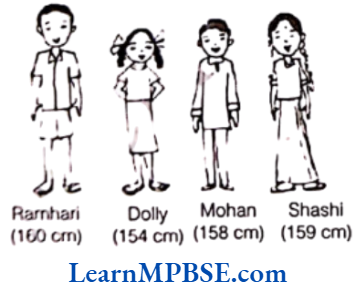
Solution. From the given figure, it is clear that
160 > 159 > 158 > 154
Ramhari is the tallest because he has the height of 160 cm.
From the given figure, it is clear that
154 < 158 < 159 < 160
∴ Dolly is the shortest because she has the height of 154 cm.
(1) Yes, we can arrange their heights in increasing order as follows: Dolly (154 cm) < Mohan (158 cm) < Shashi (159 cm) < Ramhari (160 cm).
(2) Yes, we can arrange their heights in decreasing order as follows: Ramhari (160 cm) > Shashi (159 cm) > Mohan (158 cm) > Dolly (154 cm).
Question 7. Sohan and Rita went to buy an almirah. There were many almirahs available with their price tags.
(1) Can you arrange their prices in increasing order?
(2) Can you arrange their prices in decreasing order?
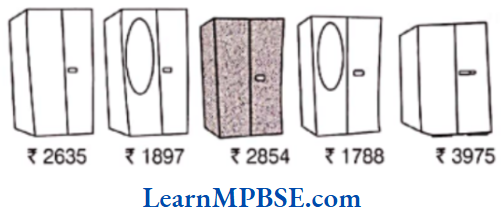
Solution. (1) Yes, prices can be arranged in increasing order as follows:
₹ 1788 < ₹ 1897 < ₹ 2635 < ₹ 2854 < ₹ 3975
(2) Yes, prices can be arranged in decreasing order as follows:
₹ 3975 > ₹ 2854 > ₹ 2635 > ₹ 1897 > ₹ 1788
Question 8 . Think of five situations, where compare three or more quantities.
Solution. Five situations may be
(1) Prices of 4 different kinds of branded shoes are 4225,3835,2620 and 2230, respectively.
(2) The weight of 4 students of Class VI are 33 kg, 38 kg, 35 kg and 37 kg, respectively.
(3) Marks obtained by 4 students in Mathematics out of 100 are 87, 88, 90 and 78, respectively.
(4) The tuition fee paid by 4 students of different classes are 170, 190, 150 and 200, respectively.
(5) The runs scored by 4 players A, B, C and D in an innings are 75, 60, 25 and 82, respectively.
Question 9. (1) Arrange the following numbers in ascending order.
(a) 847, 9754, 8320, 571
(b) 9801, 25751, 36501, 38802
(2) Arrange the following numbers in descending order.
(a) 5000, 7500, 85400, 7861
(b) 1971, 45321, 88715, 92547
Solution. (i) (a) We have, 847, 9754, 8320, 571
Ascending order of given numbers is as follows 571< 847 < 8320 < 9754
Ascending order of given numbers is as follows 9801< 25751 < 36501 < 38802
(b) We have, 9801, 25751, 36501, 38802
(2) (a) We have, 5000, 7500, 85400, 7861
Descending order of given numbers is as follows
85400 > 7861 > 7500 > 5000
(b) We have, 1971, 45321, 88715, 92547
Descending order of given numbers is as follows
92547 > 88715 > 45321 > 1971
MP Board Class 6 Maths Solutions
Question 10. Read and expand the numbers wherever there are blanks.
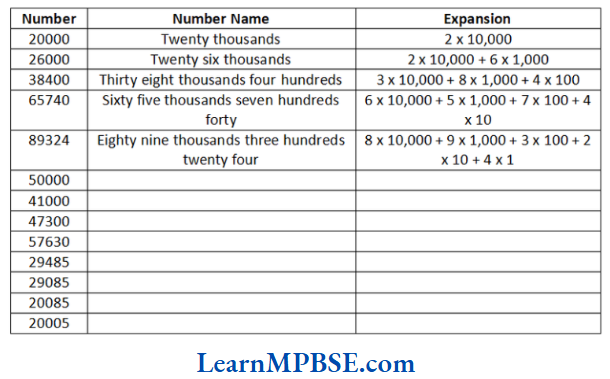
Solution. The remaining blanks are shown as below with appropriate number, name and expansion.
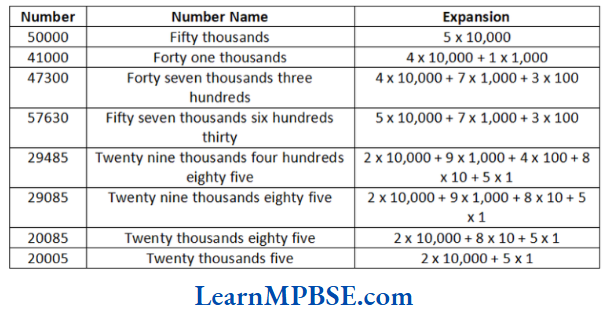
Question 11. Read and expand the numbers wherever there are blanks.
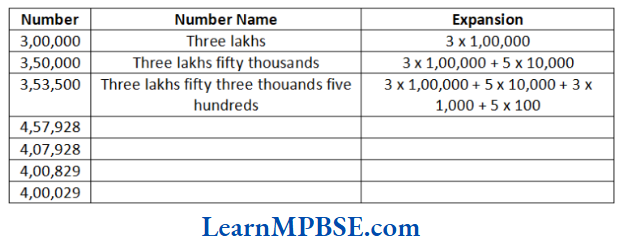
Solution. The remaining blanks are shown as below with appropriate number, name and expansion:

Question 12. (1) What is 10-1=?
(2) What is 100-1=?
(3) What is 10000 -1=?
(4) What is 100000-1 = ?
(5) What is 10000000-1 = ?
Solution.
(1) 10 – 1 = 9
(2) 100 – 1 = 99
(3) 10000 – 1 = 9999
(4) 100000 – 1 = 99999
(5) 10000000 – 1 = 9999999
MP Board Class 6 Maths Solutions
Question 13. Give five examples, where the number of things counted would be more than 6-digit number.
Solution. The least 6-digit number is 100000 (one lakh).
Now, five examples, where the number of things counted would be more than 6-digit number are as follows.
(1) The number of people in a big city.
(2) The number of stars in a clear dark night.
(3) The number of motorcycles in a big town.
(4) The number of grains in a sack full of wheat.
(5) The number of pages of notebooks of all students in a big town.
Question 14. Starting from the greatest 6-digit number, write the previous five numbers in descending order.
Solution. The greatest 6-digit number = 999999
1st previous number = 999999 – 1 = 999998
2nd previous number = 999999 – 2 = 999997
3rd previous number = 999999 – 3 = 999996
4th previous number = 999999 – 4 = 999995
5th previous number = 999999 – 5 = 999994
Now, descending order of these numbers is as follows
999998 > 999997 > 999996 > 999995 > 999994
Question 15. Starting from the smallest 8-digit number, write the next five numbers in ascending order and read them.
Solution. The smallest 8-digit number = 10000000
∴ 1st next number = 10000000 + 1 = 10000001
2nd next number = 10000000 + 2 = 10000002
3rd next number = 10000000 + 3 = 10000003
4th next number = 10000000 + 4 = 10000004
5th next number = 10000000 + 5 = 10000005
Now, ascending order of these numbers is as follows
10000001 < 10000002 < 10000003 < 10000004 < 10000005
MP Board Class 6 Maths Solutions
Question 16. Read these numbers. Write them using placement boxes and then write their expanded forms.
(1) 475320
(2) 9847215
(3) 97645310
(4) 30458094
(a) Which is the smallest number?
(b) Which is the greatest number?
(c) Arrange these numbers in ascending and descending orders.
Solution. After reading these numbers, we have
(1) 475320 Four lakhs seventy five thousands three hundred twenty.
(2) 9847215 Ninety eight lakhs forty seven thousands two hundreds fifteen.
(3) 97645310 Nine crores seventy six lakhs forty five thousands three hundreds ten.
(4) 30458094 Three crores four lakhs fifty eight thousands ninety four.
The placement boxes is shown as below

Expanded forms of given numbers are as follow
(1) 475320 = 4 × 100000 + 7 x 10000 + 5 x 1000 + 3 × 100 + 2 x 10 + 0 x 1
(2) 9847215 = 9 × 1000000 + 8 x 100000 + 4 × 10000 + 7 x 1000 + 2 × 100 + 1 x 10 + 5 x 1
(3) 97645310 = 9 x 10000000 + 7 x 1000000 + 6 x 100000 + 4 x 10000 + 5 x 1000 + 3 x 100 + 1 x 10 + 0 x 1
(4) 30458094 = 3 x 10000000 + 4 x 100000 + 5 x 10000 + 8 x 1000 + 0 x 100 + 9 x 10 + 4 × 1
(a) The smallest number = 475320
(b) The greatest number = 97645310
(c) Ascending order of given numbers are as follow
475320 < 9847215 < 30458094 < 97645310
Descending order of given numbers are as follow
97645310 > 30458094 > 9847215 > 475320
MP Board Class 6 Maths Solutions
Question 17.Read these numbers
(1) 527864
(2) 95432
(3) 18950049
(4) 70002509
(a) Write these numbers using placement boxes and then using commas in Indian system of numeration as well as International system of numeration.
(b) Arrange these in ascending and descending orders.
Solution. After reading these number, we have
(1) 527864 Five lakh twenty seven thousand eight hundred sixty four.
(2) 95432 Ninety five thousand four hundred thirty two.
(3) 18950049 One crore eighty nine lakh fifty thousands forty nine.
(4) 70002509 Seven crore two thousand five hundred nine.
(a) Using placement boxes, given number can be
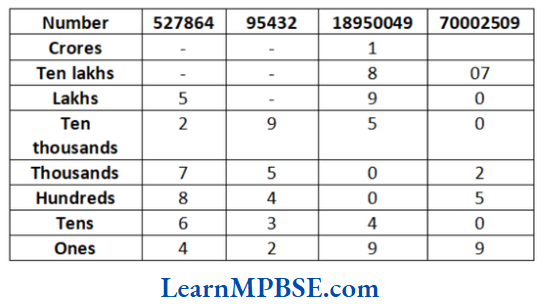
Using the commas, given numbers can be written in Indian system of numeration as
(1) 5,27,864
(2) 95,432
(3) 1,89,50,049
(4) 7,00,02,509
and in International system of numeration, they can be written as,
(1) 527,864
(2) 95,432
(3) 18,950,049
(4) 70,002,509
(b) Ascending order of these numbers are as follow
95432 < 527864 < 18950049 < 70002509
Descending order of these numbers are as follow
70002509 > 18950049 > 527864 > 95432
Question 18. You have the digits 4, 5, 6, 0, 7 and 8. Using them, make five numbers each with 6-digits.
(1) Put commas for easy reading.
(2) Arrange them in ascending and descending orders.
Solution. Given digits are 4, 5, 6, 0, 7 and 8.
We can make many numbers by using these digits, five of them are as follows
876540, 867540, 876450, 876045 and 867405
(1) After putting commas, numbers are as follows
(a) 8,76,540
(b) 8,67,540
(c) 8,76,450
(d) 8,76,045
(e) 8,67,405
(2) Ascending order of numbers is as follows
867405 < 867540 < 876045 < 876450 < 876540
Descending order of numbers is as follows:
876540 > 876450 > 876045 > 867540 > 867405
Question 19. Take the digits 4, 5, 6, 7, 8 and 9. Make any 3 numbers each with 8-digits. Put commas for easy reading.
Solution. Given digits are 4, 5, 6, 7, 8 and 9.
We can make many numbers by using these digits, three of them are as follows
98877456, 98877465 and 98877654
Using commas, numbers can be rewritten as
(1) 9,88,77,456
(2) 9,88,77,465
(3) 9,88,77,654
MP Board Class 6 Maths Solutions
Question 20. From the digits 3, 0 and 4, make five numbers each with 6-digits. Use commas.
Solution. Given digits are 3,0 and 4.
We can make many numbers by using these digits, five of them are as follows
(1) 330443
(2) 343404
(3) 344430
(4) 434043
(5) 344034
Using commas, these numbers can be rewritten as
(1) 3,30,443
(2) 3,43,404
(3) 3,44,430
(4) 4,34,043
(5) 3,44,034
Exercise 1.1
Question 1. Fill in the blanks.
(1) 1 lakh = _________ ten thousands
(2) 1 million = _______ hundred thousands
(3) 1 crore = ________ ten lakhs
(4) 1 crore = _______ millions
(5) 1 million = _______ lakhs
Solution. (1) We know that
1 lakh = 100000 (in digits) = 10 x 10000
= ten x ten thousand (in number name)
1 lakh = ten ten thousand
(2) We know that
1 million = 1000000 (in digits) = 10 x 100000
= ten x hundred thousands (in number name)
∴ 1 million = ten hundred thousands
(3) We know that
1 crore = 10000000 (in digits)
= 10 × 1000000
= ten x ten lakhs (in number name)
∴ 1 crore ten ten lakhs
(4) We know that
1 crore = 10000000 (in digits) = 10 x 1000000
= ten x one million (in number name)
∴ 1 crore = ten millions
(5) We know that
1 million = 1000000 (in digits)
= 10 x 100000 ten x one lakhs
∴ 1 million ten lakhs
Class 6 Maths Chapter 1 Solutions
Question 2. Place commas correctly and write the numerals
(1) Seventy three lakhs seventy five thousands three hundreds seven
(2) Nine crores five lakhs forty one
(3) Seven crores fifty two lakhs twenty one thousands three hundreds two
(4) Fifty eight millions four hundreds twenty three thousands two hundreds two
(5) Twenty three lakhs thirty thousands ten
Solution. Numbers after commas are as follows
(1) 73,75,307
(2) 9,05,00,041
(3) 7,52,21,302
(4) 58,423,202
(5) 23,30,010
Question 3. Insert commas suitably and write the names according to Indian system of numeration.
(1) 87595762
(2) 8546283
(3) 99900046
(4) 98432701
Solution. We can draw a table to show these operations.
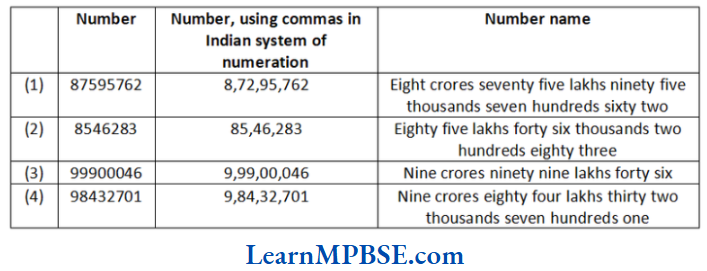
Question 4. Insert commas suitably and write the name according to International system of numeration.
(1) 78921092
(2) 7452283
(3) 99985102
(4) 48049831
Solution. We can draw a table to show these operations
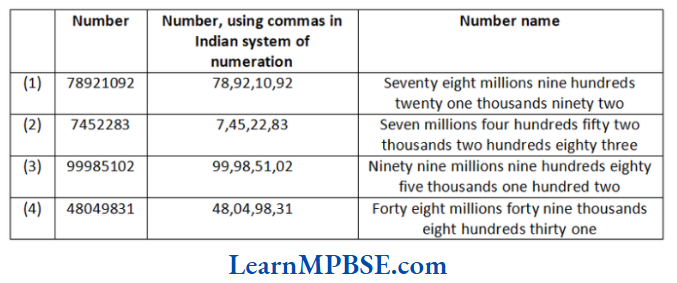
Class 6 Maths Chapter 1 Solutions
Question 5. How many centimetres make a kilometre?
Solution. We know that 1 km = 1000 m = 1000 x 100 cm [1 m = 100 cm]
= 100000 cm
Question 6. How many milligrams make one kilogram?
Solution. We know that 1 kg = 1000 g (1000 x 1000) mg
[1g = 1000 mg]
= 1000000 mg
∴ 1000000 milligrams make one kilogram.
Question 7. A box contains 200000 medicine tablets each weighing 20 mg. What is the total weight of all the tablets in the box in grams and in kilograms?
Solution. Given, weight of one tablet = 20 mg
Total weight of 200000 tablets in the box
= 200000 x 20 mg = 4000000 mg
Now, weight in grams = \(\frac{4000000}{1000} \mathrm{~g}=4000 \mathrm{~g}\)
Now, weight in kilograms = \(\frac{4000}{1000} \mathrm{~kg}=4 \mathrm{~kg}\)
Question 8.
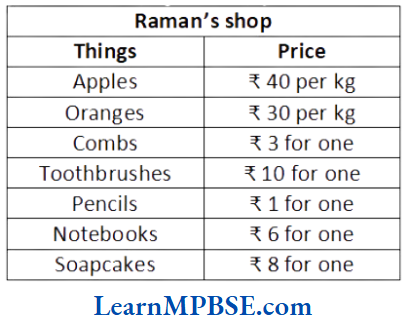
(1) Can you find the total weight of apples and oranges Raman sold last year?
Weight of apples = ______ kg
Weight of oranges = _______ kg
Therefore, total weight = ______ kg + ______ kg = _______ kg
(2) Can you find the total money Raman got by selling apples?
(3) Can you find the total money Raman got by selling apples and oranges together?
(4) Make a table showing how much money Raman received from selling each item? Arrange the entries of amount of money received in descending order. Find the item which brought him the highest amount. How much is this amount?
Solution. (1) Weight of apples sold during the last year = 2457 kg
Weight of oranges sold during the last year = 3004 kg
∴ Total weight of apples and oranges Raman sold, during the last year = 2457+ 3004 = 5461 kg
(2) Total money Raman got by selling apples
= Total weight of apples in kg x Cost per kg
= 2457 x 40 = ₹ 98280
(3) Total money Raman got by selling oranges
= Total weight of oranges in kg x Cost per kg
= 3004 x 30 = ₹ 90120
∴ Total money Raman got by selling apples and oranges together = 98280 + 90120 = ₹ 188400
(4) Following table shows the money received from selling items.

The entries of amount of money received in descending order are as follows:
₹ 253670 > ₹ 240012 > ₹ 160040 > ₹ 98280 > ₹ 90120 > ₹ 68280 > ₹ 38350
The item which brought him the highest amount is toothbrushes. This amount is ₹ 253670.
Exercise 1.2
Question 1. A book exhibition was held for four days in a school. The number of tickets sold at the counter on the first, second, third and final days was respectively 1094, 1812, 2050 and 2751. Find the total number of tickets sold on all the four days.
Solution. Given, number of tickets sold on the first day = 1094
Number of tickets sold on the second day = 1812
Number of tickets sold on the third day = 2050
Number of tickets sold on the fourth day = 2751
∴ Total number of tickets sold on all the four days
= 1094 + 1812 + 2050 + 2751 = 7707
Hence, there are 7707 tickets sold on all the four days.
Class 6 Maths Chapter 1 Solutions
Question 2. Shekhar is a famous cricket player. He has so far scored 6980 runs in test matches. He wishes to complete 10000 runs. How many more runs does he need?
Solution. Given, number of runs scored by Shekhar = 6980
Target of runs to be scored = 10000
∴ Number of runs needed more
= Target of runs – Run scored yet
= 10000 – 6980
= 3020
Question 3. In an election, the successful candidate registered 577500 votes and his nearest rival secured 348700 votes. By what margin did the successful candidate win the election?
Solution. Given, votes registered by the successful candidate = 577500
Votes registered by the nearest rival = 348700
∴ Margin, by which the successful candidate won = Votes of successful candidate – Votes of nearest rival
= 577500 – 348700 = 228800
Question 4. Kirti bookstore sold books worth ₹ 285891 In the first week of June and book worth 400768 in the second week of the month. How much was the sale for the two weeks together? In which week was the sale greater and by how much?
Solution. Given, sale of books in Ist week = ₹ 285891
Sale of books in IInd week = ₹ 400768
Total sales of two weeks = Sale of Ist week + Sale of IInd week
= 285891 + 400768 = ₹ 686659
Since, 400768 > 285891
Thus, sale in the second week is greater.
∴ Difference in the sales amount = 400768 – 285891 = ₹ 114877
Hence, sale in the second week was greater by 114877.
Question 5. Find the difference between the greatest and the least numbers that can be written using the digits 6, 2, 7, 4, 3 each only once.
Solution. Using the digits 6, 2, 7, 4 and 3, we get
Greatest number = 76432 and least number = 23467
∴ Difference = Greatest number – Least number
= 76432 – 23467 = 52965
Note it We can form a greatest number with individual digits by arranging them in descending order from right and similarly, we can form a least number by arranging them in ascending order from right.
Class 6 Maths Chapter 1 Solutions
Question 6. A machine, on an average, manufactures 2825 screws a day. How many screws did it produce in the month of January 2006?
Solution. Number of screws manufactured by the machine in one day = 2825
We know that number of days in the month of January = 31
∴ Number of screws produced by the machine in the month of January, 2006 = 2825 x 31 = 87575
Hence, the number of screws produced by the machine in the month of january, 2006 are 87575.
Question 7. A merchant had 778592 with her. She placed an order for purchasing 40 radio sets at 1200 each. How much money will remain with her after the purchase?
Solution. Given, cost of one radio set = ₹ 1200
Number of radio sets to be purchased = 40
∴ Cost of 40 radio sets = Cost of one radio set x Number of radio sets
= 40 x 1200 = ₹ 748000
∵ Total money with the merchant = ₹ 78592
∴ Money left with the merchant after purchase of 40 radio sets Total money – Cost of 40 radio sets
= 78592 – 48000
= ₹ 30592
Hence, 30592 will remain with her after the purchase.
Question 8. A student multiplied 7236 by 65 instead of multiplying by 56. By how much was his answer greater than the correct answer?
Solution. If a student multiplies 7236 by 65, he will get
= 7236 x 65 = 470340
According to the question,
Student multiplies 7236 by 56 and he will get = 7236 × 56 = 405216
Now, required difference = Actual answer – Wrong answer = 470340 – 405216 = 65124
Class 6 Maths Chapter 1 Solutions
Question 9. To stitch a shirt 2 m 15 cm cloth is needed. Out of 40 m cloth, how many shirts can be stitched and how much cloth will remain?
Solution. Total length of cloth = 40 m = 40 x 100 cm [∵ 1 m = 100 cm]
= 4000 cm
Cloth needed for one shirt = 2 m 15 cm
= (2 × 100) cm + 15 cm
= (200 + 15) cm = 215 cm
∴ Number of shirts stitched out of total cloth
\(=\frac{\text { Total length of cloth }}{\text { Cloth needed for stitched shirt }}\)= \(\frac{4000}{215}=18 \frac{130}{215}\)
Hence, 18 shirts can be stitched and cloth left over is 130 cm i.e. 1 m 30 cm.
Question 10. Medicine is packed in boxes, each weighing 4 kg 500 g. How many such boxes can be loaded In a van which cannot carry beyond 800 kg?
Solution. Given, van can carry a weight of 800 kg = 800 x 1000 g = 800000 g
[∵1 kg = 1000 g]
According to the question,
Weight of one packet = 4 kg 500 g
= 4 × 1000 + 500
= 4000 + 500 = 4500 g
∴ Number of packets that can be loaded in the van
\(=\frac{\text { Total weight strength of the van }}{\text { Weight of one packet }}\)= \(\frac{800000}{4500}=\frac{8000}{45}=177 \frac{35}{45}\)
Hence, only 177 boxes can be loaded in the van.
Question 11. The distance between the school and the house of a student’s house is 1 km 875 m. Everyday she walks both ways. Find the total distance covered by her in six days.
Solution. Given, distance between the school and the house
= 1 km 875 m = 1 x 1000 + 875
= 1000 + 875 = 1875 m
[∵ 1 km = 1000 m]
∴ Distance covered by the student in one day
= 2 x 1875 = 3750 m
[∵ she walks both ways in one day]
∴ Distance covered in 6 days = 6 x 3750 = 22500 m
= (22 × 1000 + 500) m
= 22 km 500 m
[∵ 1 km = 1000 m]
Question 12. A vessel has 4 L and 500 mL of curd. In how many glasses, each of 25 mL capacity, can it be filled?
Solution. Given, capacity of vessel = 4 L 500 mL
= 4 x 1000 + 500 = 4000 + 500 = 4500 mL
[∵ 1 L= 1000 mL]
and capacity of one glass = 25 mL
∴ Number of glasses of curd filled out of vessel Capacity of a vessel
= \(\frac{\text { Capacity of a vessel }}{\text { Capacity of a glass }}=\frac{4500}{25}=180\)
Hence, curd can be filled in 180 glasses.
Review Exercise
Multiple Choice Questions
Question 1. The greatest natural number is
- 1 crore
- 10 crores
- 10 lakhs
- Not defined
Answer. 4. Not defined
Question 2. The arrangement of 24, 68, 487; 7, 89, 540; 1, 34, 53, 879; 78, 989; 4807 in ascending order is
- 78, 989 < 4807 < 24, 68, 487 < 7, 89, 540 < 1, 34, 53, 879
- 7, 89, 540 < 1, 34, 53, 879 < 24, 68, 487 < 78, 989 <4807
- 4807 <78, 989 <7, 89, 540 < 24, 68, 487 <1, 34, 53, 879
- None of the above
Answer. 3. 4807 <78, 989 <7, 89, 540 < 24, 68, 487 <1, 34, 53, 879
Question 3. The smallest 5-digit number formed from the digits 5, 3 and 0 is
- 30500
- 53000
- 50355
- 30005
Answer. 4. 30005
Question 4. The number formed by interchanging the digits 6 and 2 in 465271 is
- 467521
- 425671
- 165274
- None of these
Answer. 2. 425671
Question 5. How many lakhs make 1 million?
- one
- ten
- hundred
- thousand
Answer. 2. ten
Question 6. The difference between a million and a thousand is
- 9990
- 99900
- 999000
- 9990000
Answer. 3. 999000
Question 7. 3691215 with commas as per the Indian system of numeration is
- 36,91,215
- 3,69,1215
- 36,912,15
- 3,69,12,15
Answer. 1. 36,91,215
Question 8. In Indian system of numeration, the number 58695376 is written as
- 58,69,53,76
- 58,695,376
- 5,86,95,376
- 586,95,376
Answer. 3. 5,86,95,376
Question 9. The expanded form of the number 9578 is
- 9 × 10000 + 5 x 1000 + 7 x 10 + 8 × 1
- 9 × 1000 + 5 x 100 + 7 x 10 + 8 x 1
- 9 x 1000 + 57 x 10 + 8 x 1.
- 9 × 100 + 5 x 100 + 7 x 10 + 8 x 1
Answer. 2. 9 × 1000 + 5 x 100 + 7 x 10 + 8 x 1
Question 10. In international system of numeration 59357258 is written as
- Fifty-nine million three hundred fifty-seven thousand two hundred fifty-eight
- Five crores ninety four lakh fifty thousand two hundred fifty eight
- Fifty nine crores three hundred fifty-seven thousand two hundred fifty-eight
- None of the above
Solution. 1. Fifty-nine million three hundred fifty-seven thousand two hundred fifty-eight
MP Board Class 6 Chapter 1 Maths
Question 11. The expression of 56,83,765 in words is
- Five crores sixty eight thousand seven hundred sixty five.
- Fifty six crores eighty three thousand seven hundred sixty five
- Five crores six hundred eighty three
- Fifty six lakh eighty three thousand seven hundred sixty five.
Answer. 4. Fifty six lakh eighty three thousand seven hundred sixty five.
Question 12. The place value of 0 in 4,30,976 is
- 3000
- 0
- 6
- 9
Answer. 2. 0
Question 13. The difference between the face value and the place value of the digit 8 in 38954
- 4992
- 6552
- 7992
- 5322
Answer. 3. 7992
Question 14. Population of Shivnagar was 458214 in 2001. In year 2004, it was found that the population increased by 123562, then the population in 2004 is
- 96522
- 628814
- 96224
- 581776
Solution. 4. 581776
Question 15. If a number 4253 multiplied by 44 instead of multiplying by 34, then the answer greater than the correct answer is
- 5232
- 42530
- 8956
- 7588
Answer. 2. 42530
MP Board solutions for Class 6 Maths Chapter 1 Assertion Reason Type Questions
Question 1. Assertion (A) 59785 is the greatest number among 382, 4972, 18, 59785, 750.
Reason (R) When a number is bigger or larger than the second or rest quantities or number it is known as greatest number.
(a) Both A and R are true and R is the correct explanation of A.
(b) Both A and R are true but R is not the correct explanation of A.
(c) A is true but R is false.
(d) A is false but R is true.
Answer. (a) Both A and R are true and R is the correct explanation of A.
Question 2. Assertion (A) 56,500,800 is correct in Indian system of numeration.
Reason (R) 10,00,00,000 is the sequence of comma in Indian system of numeration.
(a) Both A and R are true and R is the correct explanation of A.
(b) Both A and R are true but R is not the correct explanation of A.
(c) A is true but R is false.
(d) A is false but R is true.
Answer. (d) A is false but R is true.
MP Board Class 6 Chapter 1 Maths
Question 3. Assertion (A) 1 crore = 10 million
Reason (R) The smallest number of 8-digit is 1,00,00,000.
(a) Both A and R are true and R is the correct explanation of A.
(b) Both A and R are true but R is not the correct explanation of A.
(c) A is true but R is false.
(d) A is false but R is true.
Answer. (b) Both A and R are true but R is not the correct explanation of A.
MP Board solutions for Class 6 Maths Chapter 1 Fill in the Blanks
Question 1. The smallest 4-digit number with different digits is……..
Answer. 1023
Question 2. In Indian system of numeration, the number 61711682 is written, using commas, as…….
Answer. 6, 17, 11, 682
Question 3. Place value of 5 in 3546 is ……….. .
Answer. 500
Question 4. (1)1 m= …… mm
(2) 1 cm = …… mm
Answer. (1) 1000 (ii) 10
Question 5. By adding 1 to the greatest ………. digit number, we get ten lakh.
Answer. 6
MP Board solutions for Class 6 Maths Chapter 1 True/False
Question 1. 34984 = 3 x 1000 + 49 x 100 + 8 x 10 + 4 x 1
Answer. False
Question 2. 1000000 = 1 crore
Answer. False
Question 3. Face value of 7 in 754612 is 7.
Answer. True
Question 4. Smallest 5-digit number+1 = Greatest 6-digit number.
Answer. False
Question 5. The numbers 4578, 4587, 5478, 5487 are in ascending order.
Answer. True
MP Board Class 6 Chapter 1 Maths
Match the Columns
Question 1. Match the Column A with Column B.
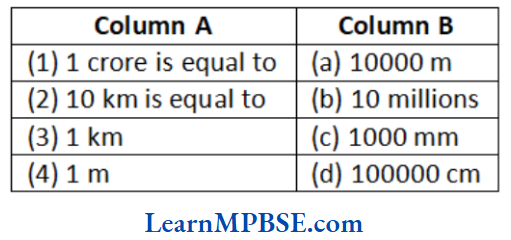
Answer. (1)(b), (2) → (a), (3) → (d), (4) → (c)
MP Board solutions for Class 6 Maths Chapter 1
Question 1. The first and last coach of the metro train are Driving mode cars. The coaches in between are Trailing cars connected through Gangways. Gangways allow passenger movement between cars. This figure shows the dimensions of a Driving mode car and Trailing car along with Gangways.
(1) A train has six coaches. What is the length of the metro train?
(a) 45 m
(b) 133 m
(c) 134 m
(d) 135 m
(2) In the 6 coach metro train, each coach has 50 seats for passengers. The first coach is reserved for women. Sixteen seats are reserved for women and senior citizens in each of the remaining coaches. How many
unreserved passenger seats are in the metro train?
(a) 130
(b) 170
(c) 204
(d) 190
(3) On an average, a metro train completes 4 round trips of 90 km in a day. What is the average distance travelled by the metro?
Solution. (1) (c) Train has two driving coaches of length 23 m and 4 trailing coaches of length 22 m.
∴ Length of metro train = 23 + 23 + 22 + 22 + 22 + 22
= 134 m
(2) (b) Since, first coach is reserved for women.
Therefore, reserved seat=50
Now, there are 5 coaches left and 16 seats are reserved in each coach.
∴ Reserved seats in 5 coach = 16 x 5 = 80 seats
Total reserved seats = 50 + 80 = 130
Total seats in metro = 50 × 6 = 300
∴ Unreserved seats = Total seats – Reserved seats
= 300 – 130 = 170 seats
(3) Metro train completes 4 round trips of 90 km in a day.
∴ Distance travelled in a day = 90 x4 = 360 km
Question 2. Passengers need a metro token to board a train. The cost of the token depends upon the distance travelled in different zones. Different zones represents different metro networks.
The table below shows the cost of tokens for travelling in different zones of a metro.
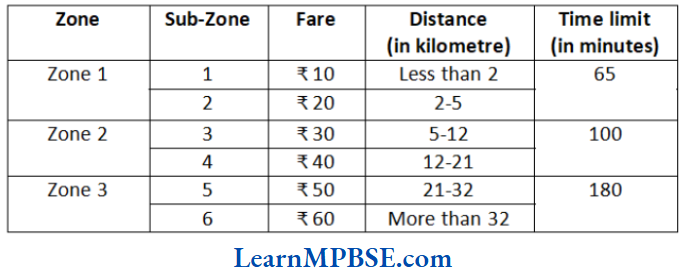
The table below shows the number of passengers travelling on a particular day in different zones.
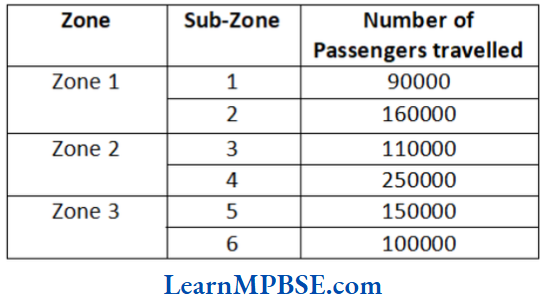
(1) How much revenue was generated on that day in Zone 1?
(2) Which zone generated the highest revenue on that day?
Solution. (1) Revenue generated in zone 1 = Revenue generated in (sub-zone 1+ sub-zone 2 + sub-zones)
Revenue generated in sub-zone 1
= Fare x Number of passenger travelled
= ₹10 × 90000 = ₹ 900000
Revenue generated in sub-zone 2 = ₹ 20 × 160000 = 3200000
Revenue generated in sub-zone 3 = ₹ 30 x 110000 = 3300000
∴ Total revenue generated in zone 1
₹ 900000 + ₹ 3200000 + ₹ 3300000 = ₹ 7400000
(2) Revenue generated in zone 1 = ₹ 7400000
Revenue generated in zone 2 = ₹ 40 x 25000
= ₹ 1000000
Revenue generated in zone 3 = ( 50 x 150000) + (₹60 x 100000)
= 13500000
Clearly, revenue generated in zone 3 is the highest.
Question 3. Siya and Aman are playing with 0-9 number cards. they placed seven cards in a row.

In how many different ways can they place the rest of the cards?
Solution. Since, we have three place left and 13 cards left has digits 0, 3, 1. We keep changing their place value by shifting digits, thus we get numbers which are 031, 013, 103, 130, 310, 301.
Therefore, there are 6 ways to place the rest of the cards.
Question 4. Siya and Aman reshuffle the cards and divide them equally. Aman makes a 5-digit number using his cards. The picture shows the number formed by Aman.
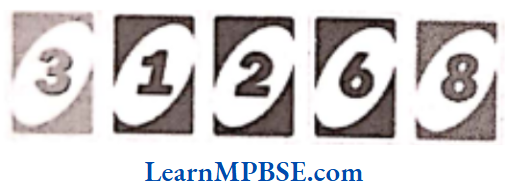
Siya placed four of her cards as shown in the picture below.
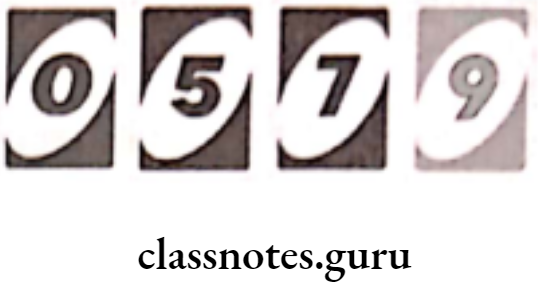
Where should she place the remaining card to form a number greater than the number formed by Aman?
(a) After 9
(b) Before 0
(c) Between 5 and 7
(d) Between 7 and 9
Solution. (b) 5-digit number made by Aman = 31268
4 – digit number made by Siya = 0579
Remaining digit of card = 4
Siya cannot place remaining card anywhere after 0 because it will be a four digit number which is less than digit formed by Aman.
Thus, to form a number greater than the number formed by Aman she should place it before 0.
∴ 40579 > 31268
MP Board Class 6 Chapter 1 Maths
Question 5. In a school, 700 students avail the school’s transport services. The transport manager of the school prints a monthly transport record. The printed record is shown below.

(1) An entry is omitted in the record. What are the monthly transport fees for a distance of less than 5 km? Show your calculation.
(2) In class 6 of a school, 105 students study in different sections. The number of students in each section are between 20 and 40. All sections have equal number of students. How equal number of students can be accommodated in each section?
(3) The school authority plans to install new water coolers. There are 1800 students in the school. A water cooler can serve 100 students. The cost of one water cooler is 40000. How many water coolers are should be installed to serve all the students? What is the cost of installing them?
Solution. (1) Total cost for less than 5 km = 200000
Number of students travelling less than 5 km = 400
∴ Monthly fee for one student = \(\frac{200000}{400}=₹ 500\)
(2) Total number of students = 105
All sections have equal students but the range lies between 20 and 40. Thus, we will do prime factorisation of 105 in required range.
21 x 5 = 105
35 x 3 = 105
∴ 5 sections with 21 students in each section and 3 sections with 35 students in each section.
(3) Total number of students = 1800
1 water cooler serves = 100 students
∴ Required number of water cooler to serve 1800
1800 students = \(\frac{1800}{100}\) = 18
Now, cost of one water cooler = 40000
∴ Cost of 18 water cooler = 18 x 40000 = 720000
MP Board solutions for Class 6 Maths Chapter 1 Very Short Answer Type Questions
Question 1. Which one is the greatest number?
(1) 47645, 48740
(2) 15896, 26760
Solution. (1) Here, ten thousands digit is 4 in both numbers. But thousands digit in 47645 is 7 and thousands digit in 48740 is 8. So, 8>7
Hence, 48740 > 47645
(2) In 15896, ten thousands digit is 1 and ten thousands digit in 26760 is 2. So, 2>1.
Hence, 26760 > 15896.
Question 2. Write the greatest and smallest of the following numbers. 29706, 28706, 39406, 87604
Solution. In the given numbers, we see that 28706 is the smallest and 87604 is the greatest.
Question 3. Using the digits 3, 5, 4, 6 without repetition, write the smallest 4-digit number.
Solution. Here, given digits are 3, 5, 4, 6. For the smallest number, we write the digits in ascending order. So, the smallest four-digit number is 3456.
Question 4. Make the greatest 5-digit number by using the digits 1, 2,7,94, without repetition.
Solution. Given, digits are 1, 2, 7, 9, 4.
For greatest number, we write the digits in descending order.
So, the greatest five-digit number is 97421.
Question 5. Arrange the following numbers in ascending order, 1462, 2605, 3164, 1562.
Solution. The ascending order of the given numbers are as follows
1462 < 1562 < 2605 < 3164
Question 6. Insert the commas in appropriate places according to the Indian system of numeration.
(1) 2464056
(2) 6896462
Solution. According to the Indian system of numeration,
(1) 24,64,056
(2) 68,96,462
Question 7. Insert the commas at appropriate places according to International system of numeration.
(1) 2546726
(2) 7869420
Solution. According to the International system of numeration,
(1) 2,546,726
(2) 7,869,420
Question 8. Write the numeral for the following
Twenty millions five hundreds two thousands and six hundreds thirty two.
Solution. The numeral form is 20,502,632.
Question 9. Write the place value of 6 in 762540.
Solution. The place value of 6 in 762540 = 6 × 10000 = 60000
Question 10. Write the expanded form of the following.
(1) 76496
(2) 986256
Solution. Expanded form of given numbers as
(1) 76496 = 7 x 10000 + 6 x 1000 + 4 x 100 + 9 × 10 + 6
(2) 986256 = 9 × 100000 + 8 x 10000 + 6 × 1000 + 2 × 100 + 5 x 10 + 6
Short Answer Type Questions
Question 1. Make the greatest and smallest five digit numbers by using the following digits (without repetition).
(1) 4, 5, 6, 7, 2
(2) 2, 0, 7, 3, 8
Solution. Here, we have
The greatest five-digit number is 76542. The smallest five-digit number is 24567.
The greatest five-digit number is 87320. The smallest five-digit number is 20378.
Question 2. Write the numeral for the following.
(1) Thirty seven lakhs, forty eight thousands and seven hundreds sixty three.
(2) Thirty two millions, six hundreds sixty thousands and five hundreds five.
(3) Twenty lakhs, four thousands four.
Solution. 37,48,763
32,660,505
20,04,004
Question 3. Find the difference between the place value of two 6’s in 6523689.
Solution. Given, number is 6523689.
Place value of first 6 = 6 x 1000000
= 6000000
Place value of second 6 = 6 x 100 = 600
∴ Difference between the place values of two 6’s
= 6000000 – 600
= 5999400
Question 4. The piece of cloth required for a shirt is 3m 05 cm. How much cloth will be required for 14 shirts?
Solution. Cloth required for 1 shirt = 3 m 05 cm
Cloth required for 14 shirts = (3 m 05 cm) x 14
= 14 x 3 + 14 x 05 = 42 m 70 cm
Question 5. A bus can covers 1126 km in 18 h. At what speed per hour does the bus move?
Solution. Distance covered in 18 h = 1126 km
Distance covered in 1 h = 1126 + 18 = 62 km 555 m
Hence, the speed of the car is 62 km 555 m per hour.
Question 6. The mass of a gas cylinder is 14 kg 250 g. Find the total mass of 20 such cylinder.
Solution. Given, mass of a cylinder = 14 kg 250 g
Mass of 20 cylinders = 20x (14 kg + 250 g)
= 280 kg + 5000 g
= 280 kg + 5 kg = 285 kg
Question 7. A man saves ₹ 250 per month. How much money will save in 2 yr?
Solution. Monthly saving = ₹250
We know that 1 yr = 12 months, 2 yr = 24 months
Total saving in 2 yr = 24 × 250 = ₹ 6000
Question 8. The cost of 20 flats constructed by DDA housing scheme is ₹ 348642060. What is the cost of each flat?
Solution. Total cost of 20 flats = 348642060
Cost of each flat = 348642060 ÷ 20 = 17432103
Question 9. How much money was collected from 1261 students of a school for a charity show, if each student contributed ₹ 520?
Solution. Total number of students in school = 1261
Contribution of money by each student = 520
∴ Total money = 1261 × 520 = 655720
Question 10. Out of 180000 tablets of vitamin A, 18734 are distributed among the students in a district. Find the number of the remaining vitamin tablets.
Solution. Total tablets of vitamin A = 180000
Tablets distributed among children = 18734
Remaining tablets = 180000 -18734
Now, 180000 – 18734 = 161266
∴ Remaining tablets are 161266.
MP Board solutions for Class 6 Maths Chapter 1 Long Answer Type Questions
Question 1. Find the sum of greatest and the smallest 6-digit numbers formed by digits 2, 0, 4, 7, 6, 3 using each digit only once.
Solution. Given digits are 2, 0, 4, 7, 6, 3.
Using each digit only once,
The greatest 6-digit number is 764320.
The smallest 6-digit number is 203467.
Now, sum of these numbers = 764320 + 203467
= 967787
Question 2. In a 5-digit number, digit at tens place is 4, digit at units place is one-fourth of tens place digit, digit at hundreds place is 0, digit at thousands place is 5 times of the digit at units place and ten thousands place digit is double the digit at tens place. Find the number.
Solution. According to the question,
Digit at tens place = 4
Digit at unit place = \(\frac{1}{4}\) of tens place digit = \(\frac{1}{4} \times 4=1\)
Digit at hundreds place = 0
Digit at thousands place = 5 x Digit of unit place
= 5 x 1 = 5
Digit at ten thousands place = 2 x Digit of tens place
= 2 x 4 = 8
∴ Required number = 85041
Question 3. In a 5-digit number, digit at hundreds place is 6, digit at tens place is half of it, digit at unit place is the difference of the digits at hundreds and the tens place. The digit at thousands place is twice the digit at ones place and ten thousands place digit is same as that of tens place. Write the number.
Solution. Digit at hundreds place = 6
Digit at tens place = Half of 6 = 3
Digit at unit place or ones place = Difference of digits at hundreds and tens place
= 6 – 3 = 3
Digit at thousands place = Twice the digit at ones place
i.e. 2 x 3 = 6
Digit at ten thousands place = Digit at tens place = 3
So, the required number is 36633.
Question 4. Reshma’s school is \(\frac{8}{10}\) km away from her house. Daily she walks a distance and then takes a bus to travel \(\frac{1}{2}\) km to reach the school. How far does she walk?
Solution. Distance between her house to the school = \(\frac{8}{10}\) km
Distance covered by bus = \(\frac{1}{2}\) km
She walks distance = \(\left(\frac{8}{10}-\frac{1}{2}\right)=\frac{8-5}{10}=\frac{3}{10} \mathrm{~km}\)
= \(\frac{3 \times 1000}{10}=300 \mathrm{~m}\)
Question 5. There was a stock of 17380200 kg of wheat in a godown of the food corporation of India. Out of this stock, 2756744 kg of wheat was sent to Delhi and 4863108 kg to UP. How much is the balance stock now?
Solution. We have, Total stock of wheat = 17380200 kg
Quantity of wheat sent to Delhi = 2756744 kg
Quantity of wheat sent to UP = 4863108 kg
Total quantity of wheat taken out of the godown
= 2756744 + 4863108 = 7619852 kg
Balance stock of wheat in godown
= 17380200 – 7619852 = 9760348 kg
Hence, 9760348 kg balanced stock wheat in godown.
Question 6. A factory has a container filled with 35874 L of cold drink. In how many bottles of 200 mL capacity each can it be filled?
Solution. Cold drink in the container = 35874 L
= 35874 x 1000 mL = 35874000 mL
Capacity of each bottle= 200 mL
Hence, the number of bottles filled is 35874000 ÷ 200 mL.
Now,
Diagram
Thus, 179370 bottles are filled.
Question 7. Floor of a room measures 4.5m x 3m. Find the minimum number of complete square marble slabs of equal size required to cover the entire floor.
Solution. To find, the minimum number of square slabs to cover the floor, we have to find the greatest size of each such slab.
For this purpose, we have to find the HCF of 450 and 300.
[since, 4.5 m 450 cm and 3 m = 300 cm)
Now, HCF of 450 and 300 = 150
∵ Required size of the slab = 150 cm x 150 cm
∴ \(\text { Number of required slabs }=\frac{\text { Area of the floor }}{\text { Area of one slab }}\)
= \(\frac{450 \times 300}{150 \times 150}=6\)
Hence, the number of slabs is required 6.
Question 8. India’s population has been steadily increasing from 439 millions in 2001. Find the total increase in population from 1961 to 2001. Write the increase in population in Indian system of numeration, using commas suitably.
Solution. Given, population of India in 1961=439 millions
= 439 × 1000000
= 439000000 [∵ 1 million 1000000]
and population of India in 2001 = 1028 millions
= 1028 x 1000000
= 1028000000
[∵ 1 million = 1000000]
∴ Total increase in population from 1961 to 2001
= Population in 2001 – Population in 1961
= 1028000000 – 439000000
= 589000000
= 589 × 1000000
= 589 millions
So, the increase population in Indian system of numeration = 58,90,00,000
Question 9. Chinmay had ₹ 610000. He gave ₹ 87500 to Jyoti, ₹ 126380 to Javed and ₹ 350000 to John. How much money was left with him?
Solution: Given, Chinmay’s total money=610000
Money given to Jyoti by Chinmay=87500
Money given to Javed by Chinmay = 126380
Money given to John by Chinmay = 350000
∴ Money left with Chinmay
= Total money – Distributed money
= 610000-(87500 +126380 + 350000)
= 610000 – 563880
= ₹ 46120
Hence, ₹46120 was left with him.

